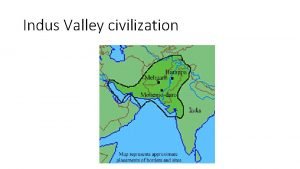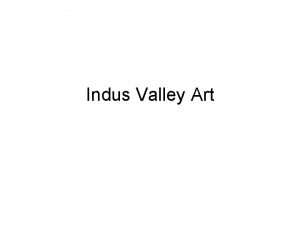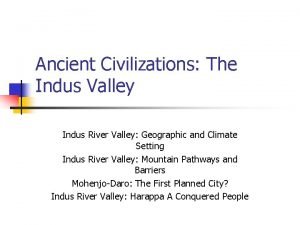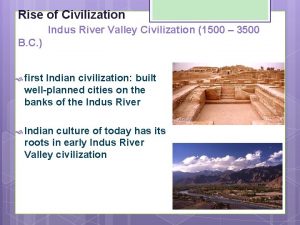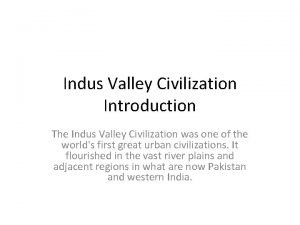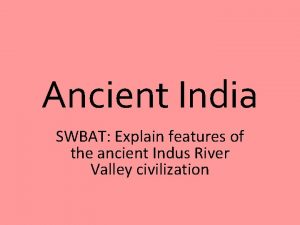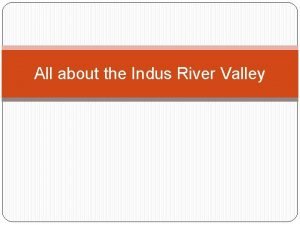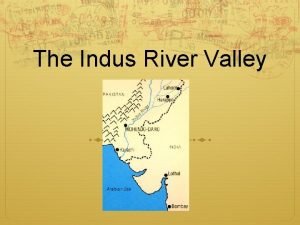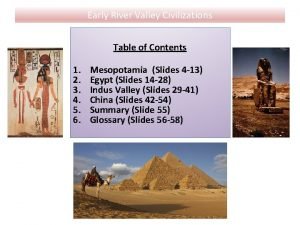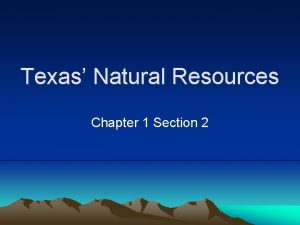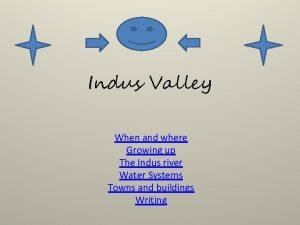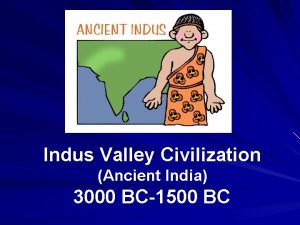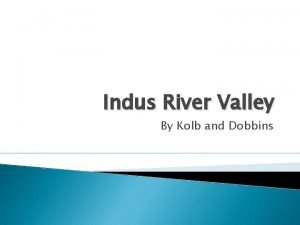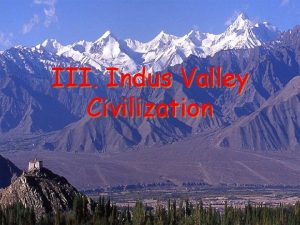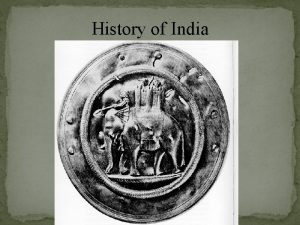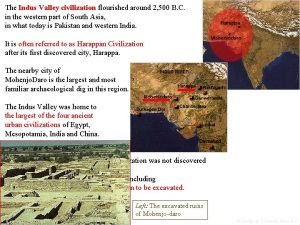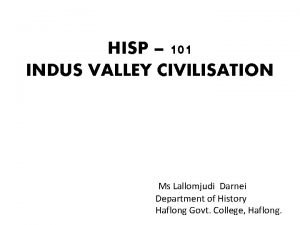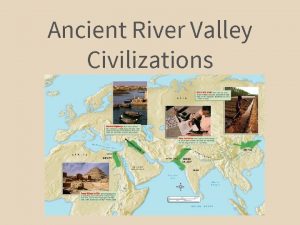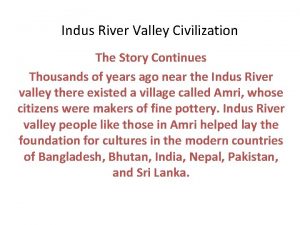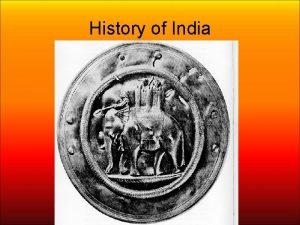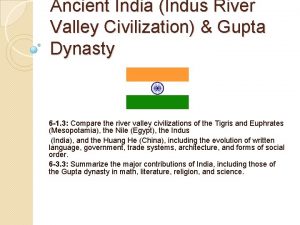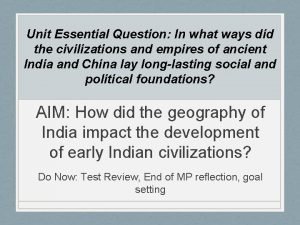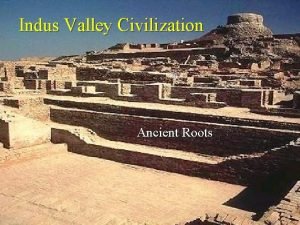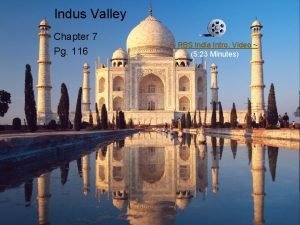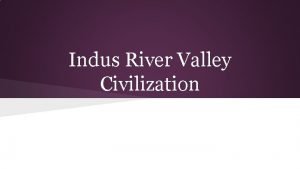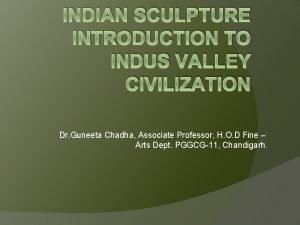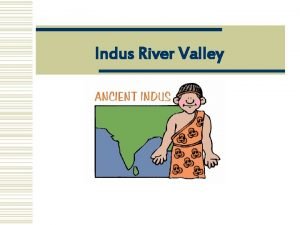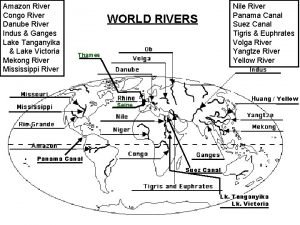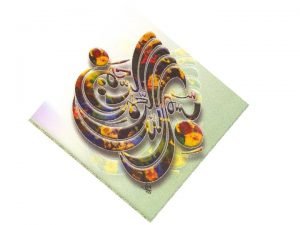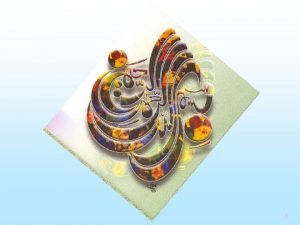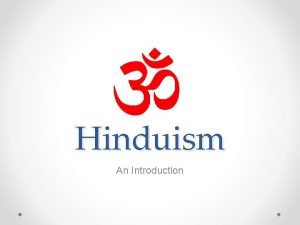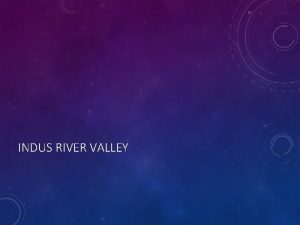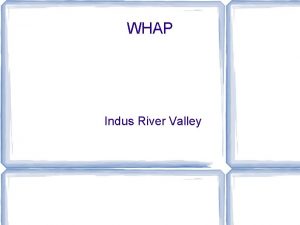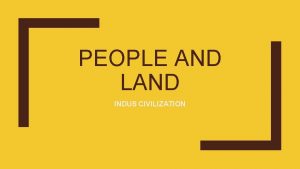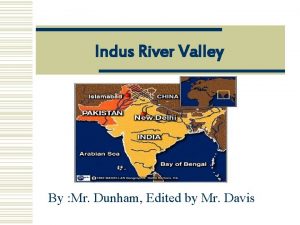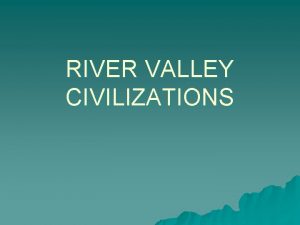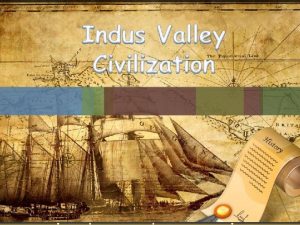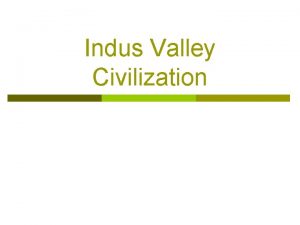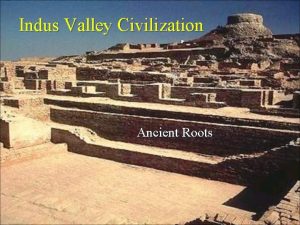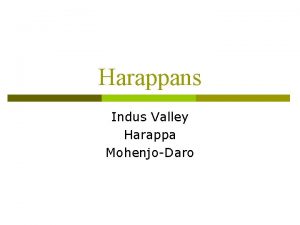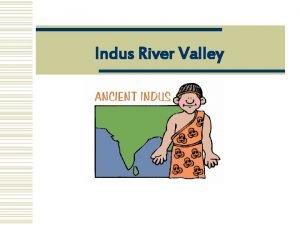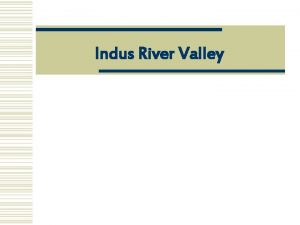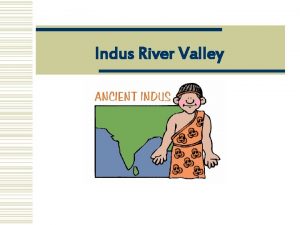Indus River Valley Mr Dunham Review w Rivers










































- Slides: 42

Indus River Valley Mr. Dunham

Review w Rivers n Names, Geographic Features w Writing Systems w Nomads w Architecture-Buildings n What was their purpose?

What We Will Learn Today: How did geography effect the Indus River Valley civilization?

India’s Geographic Features w The Indian subcontinent is a large, wedge-shaped peninsula that extends southward into the Indian Ocean. w Subcontinent: A large region that is part of a continent, but is separated from the rest of the content in some way.





Identification of Geographic Features in India Indus River Ganges River Peninsula and/or Subcontinent

Himalayan Mountains w This peninsula is surrounded on the north and northwest by huge mountains, the Himalayan Mountains. w This has often limited India's contact with other cultures. This is known as cultural isolation. w You decide! How would isolation impact the people on Ancient Indus?

Seasonal winds known as monsoons bring rain every summer. India is dependent upon monsoons to grow their crops. Not enough rain brings drought. When there is too much rain, rivers rise and cause deadly floods and destruction of crops.



Civilization in the Indus River Valley Begins w About 2500 BC, about the time when the pyramids were rising in Egypt, the first Indian civilizations were forming in the Indus River Valley. w Little is known about these civilizations, but Harappa and Mohenjo-Daro were most likely twin capital cities.

Purpose of Early Cities w Each city was large in area and contained a large structure located on a hilltop. w Many believe these structures could have served as a fortress or even a temple.




Film: Early History of India

Complexities of the Cities w The most historically striking feature of these two cities were the way in which they were both well planned. w Each city was laid out in a grid pattern, the blocks similar to those seen in modern cities. w The homes seem to have been built with bricks and in a pattern repeated throughout the city.

Plumbing In the Cities w In addition, these cities seem to contain houses with plumbing systems, including baths, drains and water pipes.


Trade with Sumer w Most of the people of the Indus valley were farmers. They were the first people to grow cotton and weave it into cloth. w There is early evidence of trade with other civilizations including Sumer.

Aryans Take over Indus Valley w Just like not much is known about the development of this region, not much is known about its decline. w For unknown reasons, around 1750 B. C. the Indus Valley began to decline. Then about 1500 B. C. , nomadic warriors known as the Aryans conquered the Indus Valley.

“The Ruins Keep Some Secrets” w Begin Reading Now & Finish for Homework! w Questions 1 -5. n Make sure to use complete sentences!

Huang He River Valley

China’s Geographic Features Huang He or Yellow River Yangzi River ~ Chinese civilization grew up in the river valley of the Huang He River (a. k. a. the Yellow River) and the Yangzi River.

Huang Ye River or Yellow River

The mountains, deserts, jungles and other geographic features have isolated Chinese culture. Having little contact with others , the Chinese believed their culture was the center of the earth.

~ Although China covers a huge area, until recent times, most people lived only along the east coast or in the river valley.



Early Views w The Chinese called themselves “The Middle Kingdom” because they believed they were at the center. w This is an example of ethnocentrism.

Shang Dynasty w About 1650 BC, the Shang gained control of northern China. Ruling families began to gain control, similar to small kingdoms. w The Shang set up the first dynasty. n Dynasty: A series of rulers from a family.


w The ancient civilization was much like others with nobility owning the land, merchants and craftspeople trading and living in the cities and a large population of peasants living in surrounding villages.

Polytheistic Peoples w Early Chinese people were polytheistic, and prayed to many Gods and nature spirits. w They also looked to dead relatives to help them in daily life and to help them please the Gods.



Ying and Yang w Many Chinese also believed that the universe held a delicate balance between opposing forces. w The Ying and Yang must be in balance for prosperity and happiness to occur in one’s life.

Early Writing System w The Chinese civilizations made achievements in early writing systems that include both pictographs and ideographs and is now as one of the earliest writing systems.

 Indus river valley hinduism
Indus river valley hinduism Indus river valley art
Indus river valley art Harappa
Harappa Indus river valley timeline
Indus river valley timeline Introduction of indus valley civilization
Introduction of indus valley civilization Indus river valley dbq
Indus river valley dbq Indus river valley job specialization
Indus river valley job specialization Indus river valley gender roles
Indus river valley gender roles Indus and ganges river
Indus and ganges river Mesopotamia technology
Mesopotamia technology Why are some rivers in texas called “wrong way” rivers?
Why are some rivers in texas called “wrong way” rivers? Growing up in the indus valley
Growing up in the indus valley Medicine in ancient india
Medicine in ancient india Indus valley civilization education
Indus valley civilization education Growing up in the indus valley
Growing up in the indus valley Religious beliefs of indus valley civilization
Religious beliefs of indus valley civilization Economy in indus valley civilization
Economy in indus valley civilization Indus valley road
Indus valley road Indus valley civilization trade and economy
Indus valley civilization trade and economy Who discovered indus valley civilization
Who discovered indus valley civilization Katangian ng kabihasnang sumer
Katangian ng kabihasnang sumer Indus valley civilization conclusion
Indus valley civilization conclusion Indus valley seal
Indus valley seal Ancient india natural resources
Ancient india natural resources Indus valley civilization recreation
Indus valley civilization recreation Economy of indus valley civilization
Economy of indus valley civilization Caste system in indus valley civilization
Caste system in indus valley civilization Harappan civilization map
Harappan civilization map Project on harappan civilization
Project on harappan civilization Indus valley pictures
Indus valley pictures Indus valley civilization period
Indus valley civilization period Conclusion of harappan civilization
Conclusion of harappan civilization Introduction of indus valley civilization
Introduction of indus valley civilization Introduction about indus valley civilization
Introduction about indus valley civilization Indus and ganges river
Indus and ganges river Indus and ganges river
Indus and ganges river Where is the indus and ganges river located
Where is the indus and ganges river located Indus river system authority was established in
Indus river system authority was established in Irsa established in
Irsa established in 4 paths to salvation hinduism
4 paths to salvation hinduism Rocas carbonatadas ejemplos
Rocas carbonatadas ejemplos St mark's church dunham massey
St mark's church dunham massey Dunham koppel
Dunham koppel
